A Field Study of Coal Fire Areas Re-Burning Behavior Assessment and Related Carbon Emissions
Abstract
1. Introduction
2. Materials and Methods
2.1. Study Area
2.2. System Overview
2.3. System Arrangement
2.4. Data Pre-Processing and Analysis
3. Result Analysis
3.1. Emission Characteristics of Spontaneous Combustion Gas
3.2. Variation Characteristics of Meteorological Factors
3.3. Variations in Thermophysical Characteristics of the Fissure
4. Discussion
4.1. Correlation ansalysis
4.2. Coal Seam Re-Burning Status Assessment
4.3. Estimated Carbon Emissions
5. Conclusions
Author Contributions
Funding
Conflicts of Interest
References
- Deng, J.; Ge, S.; Qi, H.; Zhou, F.; Shi, B. Underground coal fire emission of spontaneous combustion, Sandaoba coalfield in Xinjiang, China: Investigation and analysis. Sci. Total Environ. 2021, 777, 146080. [Google Scholar] [CrossRef] [PubMed]
- Dindarloo, S.R.; Hood, M.M.; Bagherieh, A.; Hower, J.C. A statistical assessment of carbon monoxide emissions from the Truman Shepherd coal fire, Floyd County, Kentucky. Int. J. Coal Geol. 2015, 144, 88–97. [Google Scholar] [CrossRef]
- Wang, S.F.; Li, X.B.; Wang, D.M. Mining-induced void distribution and application in the hydro-thermal investigation and control of an underground coal fire: A case study. Process Saf. Environ. 2016, 102, 734–756. [Google Scholar] [CrossRef]
- Singh, N.; Chatterjee, R.S.; Kumar, D.; Panigrahi, D.C. Spatio-temporal variation and propagation direction of coal fire in Jharia Coalfield, India by satellite-based multi-temporal night-time land surface temperature imaging. Int. J. Min. Sci. Technol. 2021, 31, 765–778. [Google Scholar] [CrossRef]
- Du, B.; Liang, Y.T.; Tian, F.C. Detecting concealed fire sources in coalfield fires: An application study. Fire Saf. J. 2021, 121, 103298. [Google Scholar] [CrossRef]
- Melody, S.M.; Johnston, F.H. Coal mine fires and human health: What do we know? Int. J. Coal Geol. 2015, 152, 1–14. [Google Scholar] [CrossRef]
- Shao, Z.L.; Wang, D.M.; Wang, Y.M.; Zhong, X.X.; Tang, X.F.; Hu, X.M. Controlling coal fires using the three-phase foam and water mist techniques in the Anjialing Open Pit Mine, China. Nat. Hazards 2015, 75, 1833–1852. [Google Scholar] [CrossRef]
- Kuenzer, C.; Stracher, G.B. Geomorphology of coal seam fires. Geomorphology 2012, 138, 209–222. [Google Scholar] [CrossRef]
- Kus, J. Impact of underground coal fire on coal petrographic properties of high volatile bituminous coals: A case study from coal fire zone No. 3.2 in the Wuda Coalfield, Inner Mongolia Autonomous Region, North China. Int. J. Coal Geol. 2017, 171, 185–211. [Google Scholar] [CrossRef]
- Zhang, J. Underground Coal Fires in China: Origin, Detection, Fire-Fighting,and Prevention; China Coal Industry Publishing House: Beijing, China, 2008. [Google Scholar]
- Wang, H.Y.; Zhang, J.P.; Zhang, L.; Wang, J.L.; Xu, Z.H. Gas Emission and Soil Chemical Properties Associated with Underground Coal Fires, Wuda Coalfield, Inner Mongolia, China. Nat. Resour. Res. 2020, 29, 3973–3985. [Google Scholar] [CrossRef]
- Li, C.H.; Liang, H.D.; Liang, M.; Chen, Y.; Zhou, Y. Soil surface Hg emission flux in coalfield in Wuda, Inner Mongolia, China. Environ. Sci. Pollut. Res. 2018, 25, 16652–16663. [Google Scholar] [CrossRef]
- Wang, H.; Zhang, J.; Zhang, L.; Wang, J.; Xu, Z. A survey on the gas emissions and soil properties near the surface in a coal fire area. Arab. J. Geosci. 2021, 14, 1–14. [Google Scholar] [CrossRef]
- Hong, X.P.; Liang, H.D.; Lv, S.; Jia, Y.R.; Zhao, T.C.; Liang, W.L. Mercury emissions from dynamic monitoring holes of underground coal fires in the Wuda Coalfield, Inner Mongolia, China. Int. J. Coal Geol. 2017, 181, 78–86. [Google Scholar] [CrossRef]
- Tang, Y.B.; Wang, H.A. Experimental investigation on microstructure evolution and spontaneous combustion properties of secondary oxidation of lignite. Process Saf. Environ. 2019, 124, 143–150. [Google Scholar] [CrossRef]
- Querol, X.; Zhuang, X.; Font, O.; Izquierdo, M.; Alastuey, A.; Castro, I.; van Drooge, B.L.; Moreno, T.; Grimalt, J.O.; Elvira, J.; et al. Influence of soil cover on reducing the environmental impact of spontaneous coal combustion in coal waste gobs: A review and new experimental data. Int. J. Coal Geol. 2011, 85, 2–22. [Google Scholar] [CrossRef]
- Niu, H.Y.; Yang, Y.X.; Bu, Y.C.; Li, S.P. Study on Spontaneous Combustion Characteristics of Coal Samples with Different Pre-oxidized Temperatures in Secondary Oxidation Process. Combust. Sci. Technol. 2021, 1–14. [Google Scholar] [CrossRef]
- Deng, J.; Li, Q.W.; Xiao, Y.; Shu, C.M. Experimental study on the thermal properties of coal during pyrolysis, oxidation, and re-oxidation. Appl. Therm. Eng. 2017, 110, 1137–1152. [Google Scholar] [CrossRef]
- Wang, G.; Liu, Q.Q.; Sun, L.L.; Song, X.; Du, W.Z.; Yan, D.C.; Wang, Y. Secondary Spontaneous Combustion Characteristics of Coal Based on Programed Temperature Experiments. J. Energy Resour. Technol. 2018, 140, 082204. [Google Scholar] [CrossRef]
- Wen, H.; Yu, Z.J.; Fan, S.X.; Zhai, X.W.; Liu, W.Y. Prediction of Spontaneous Combustion Potential of Coal in the Gob Area Using CO Extreme Concentration: A Case Study. Combust. Sci. Technol. 2017, 189, 1713–1727. [Google Scholar] [CrossRef]
- Song, J.J.; Deng, J.; Zhao, J.Y.; Zhang, Y.N.; Wang, C.P.; Shu, C.M. Critical particle size analysis of gas emission under high-temperature oxidation of weathered coal. Energy 2021, 214, 118995. [Google Scholar] [CrossRef]
- Ma, L.; Zou, L.; Ren, L.F.; Chung, Y.H.; Zhang, P.Y.; Shu, C.M. Prediction indices and limiting parameters of coal spontaneous combustion in the Huainan mining area in China. Fuel 2020, 264, 116883. [Google Scholar] [CrossRef]
- Engle, M.A.; Radke, L.F.; Heffern, E.L.; O’Keefe, J.M.K.; Smeltzer, C.D.; Hower, J.C.; Hower, J.M.; Prakash, A.; Kolker, A.; Eatwell, R.J.; et al. Quantifying greenhouse gas emissions from coal fires using airborne and ground-based methods. Int. J. Coal Geol. 2011, 88, 147–151. [Google Scholar] [CrossRef]
- Van Dijk, P.; Zhang, J.Z.; Jun, W.; Kuenzer, C.; Wolf, K.H. Assessment of the contribution of in-situ combustion of coal to greenhouse gas emission; based on a comparison of Chinese mining information to previous remote sensing estimates. Int. J. Coal Geol. 2011, 86, 108–119. [Google Scholar] [CrossRef]
- Mohalik, N.K.; Lester, E.; Lowndes, I.S.; Singh, V.K. Estimation of greenhouse gas emissions from spontaneous combustion/fire of coal in opencast mines-Indian context. Carbon Manag. 2016, 7, 317–332. [Google Scholar] [CrossRef]
- Kuenzer, C.; Zhang, J.; Tetzlaff, A.; van Dijk, P.; Voigt, S. Uncontrolled coal fires and their environmental impacts: Investigating two arid mining regions in north-central China. Appl. Geogr. 2007, 27, 42–62. [Google Scholar] [CrossRef]
- Wang, Y.M.; Li, X.Q.; Wang, W.Z.; Guo, Z.X. Experimental and in-situ estimation on hydrogen and methane emission from spontaneous gasification in coal fire. Int. J. Hydrogen Energy 2017, 42, 18728–18733. [Google Scholar] [CrossRef]
- Wang, H.; Zhang, J.; Cheng, H.; Yang, Y.; Wang, L.; Sun, X. Surface-Based CO2 Detection to Identify and Monitor Underground Coal Fires. Nat. Resour. Res. 2022, 31, 551–569. [Google Scholar] [CrossRef]
- Ide, S.T.; Orr, F.M. Comparison of methods to estimate the rate of CO2 emissions and coal consumption from a coal fire near Durango, CO. Int. J. Coal Geol. 2011, 86, 95–107. [Google Scholar] [CrossRef]
- Kuenzer, C.; Zhang, J.Z.; Sun, Y.L.; Jia, Y.R.; Dech, S. Coal fires revisited: The Wuda coal field in the aftermath of extensive coal fire research and accelerating extinguishing activities. Int. J. Coal Geol. 2012, 102, 75–86. [Google Scholar] [CrossRef]
- Feng, X.; Li, Q.; Zhu, Y.J.; Hou, J.X.; Jin, L.Y.; Wang, J.J. Artificial neural networks forecasting of PM2.5 pollution using air mass trajectory based geographic model and wavelet transformation. Atmos. Environ. 2015, 107, 118–128. [Google Scholar] [CrossRef]
- Scharf, F.; Widmann, A.; Bonmassar, C.; Wetzel, N. A tutorial on the use of temporal principal component analysis in developmental ERP research-Opportunities and challenges. Dev. Cogn. Neurosci. 2022, 54, 101072. [Google Scholar] [CrossRef] [PubMed]
- Xu, Y.P.; Wu, Z.Y. Parameter identification of unsaturated seepage model of core rockfill dams using principal component analysis and multi-objective optimization. Structures 2022, 45, 145–162. [Google Scholar] [CrossRef]
- Cheng, Y.; Zhang, H.; Liu, Z.H.; Chen, L.F.; Wang, P. Hybrid algorithm for short-term forecasting of PM2.5 in China. Atmos. Environ. 2019, 200, 264–279. [Google Scholar] [CrossRef]
- Garcia-Hurtado, E.; Pey, J.; Baeza, M.J.; Carrara, A.; Llovet, J.; Querol, X.; Alastuey, A.; Vallejo, V.R. Carbon emissions in Mediterranean shrubland wildfires: An experimental approach. Atmos. Environ. 2013, 69, 86–93. [Google Scholar] [CrossRef]
- Li, J.L.; Lu, W.; Liang, Y.T.; Qi, G.S.; Kong, B.; Hu, X.M. Variation of CO2/CO ratio during pure-oxidation of feed coal. Fuel 2020, 262, 116588. [Google Scholar] [CrossRef]
- O’Keefe, J.M.K.; Henke, K.R.; Hower, J.C.; Engle, M.A.; Stracher, G.B.; Stucker, J.D.; Drew, J.W.; Staggs, W.D.; Murray, T.M.; Hammond, M.L.; et al. CO2, CO, and Hg emissions from the Truman Shepherd and Ruth Mullins coal fires, eastern Kentucky, USA. Sci. Total Environ. 2010, 408, 1628–1633. [Google Scholar] [CrossRef]
- Hower, J.C.; Copley, G.C.; O’Keefe, J.M.K.; Hower, J.M. The further adventures of Tin Man: Vertical temperature gradients at the Lotts Creek coal mine fire, Perry County, Kentucky. Int. J. Coal Geol. 2012, 101, 16–20. [Google Scholar] [CrossRef]
- O’Keefe, J.M.K.; Neace, E.R.; Hammond, M.L.; Hower, J.C.; Engle, M.A.; East, J.; Geboy, N.J.; Olea, R.A.; Henke, K.R.; Copley, G.C.; et al. Gas emissions, tars, and secondary minerals at the Ruth Mullins and Tiptop coal mine fires. Int. J. Coal Geol. 2018, 195, 304–316. [Google Scholar] [CrossRef]
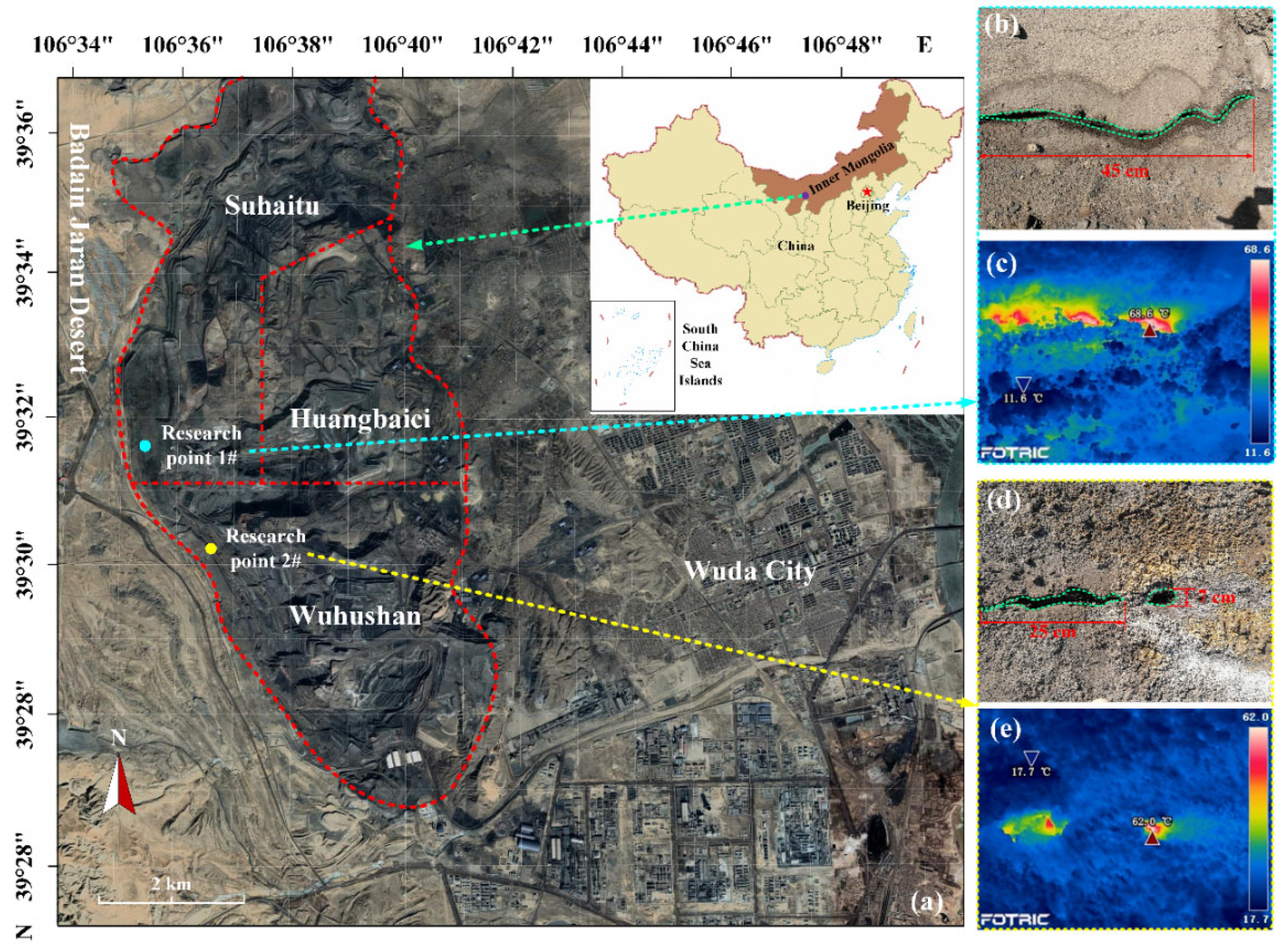
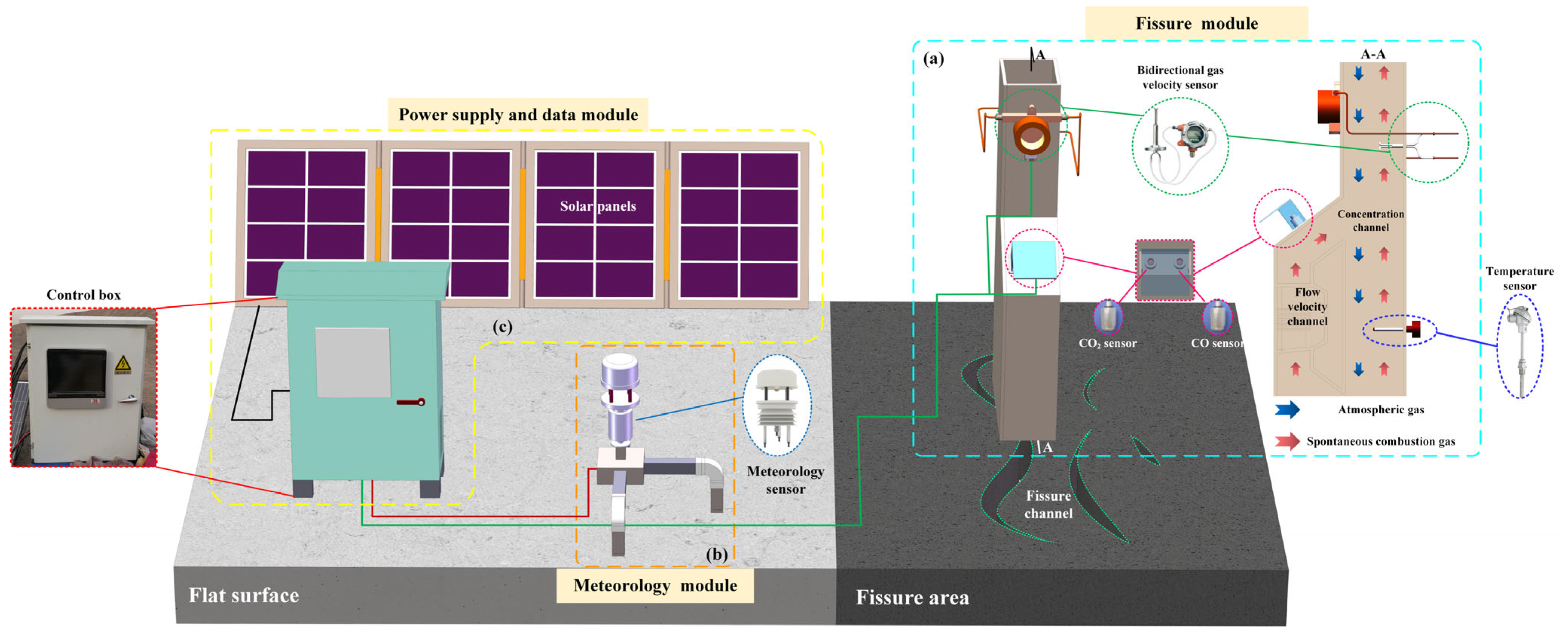
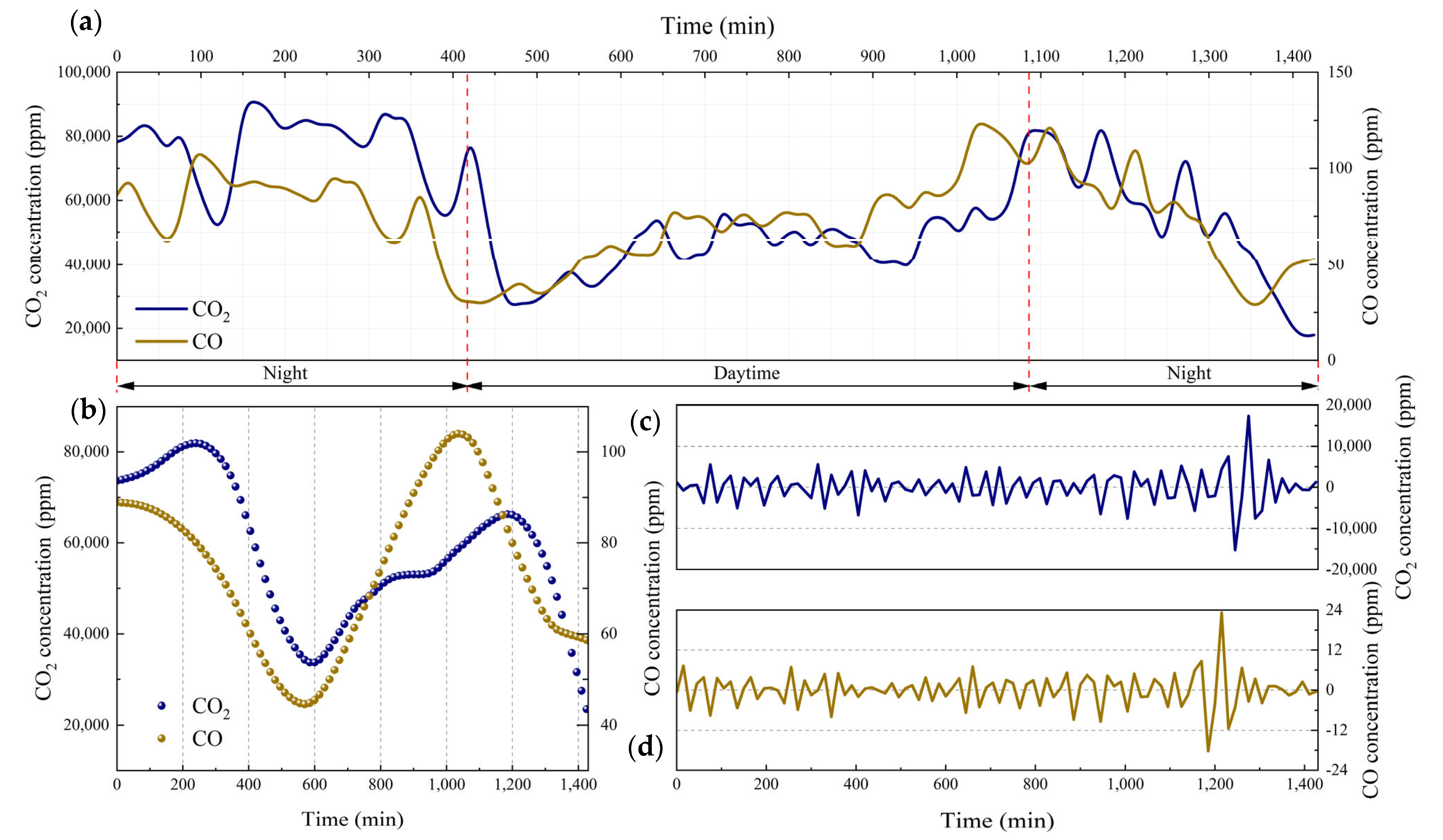

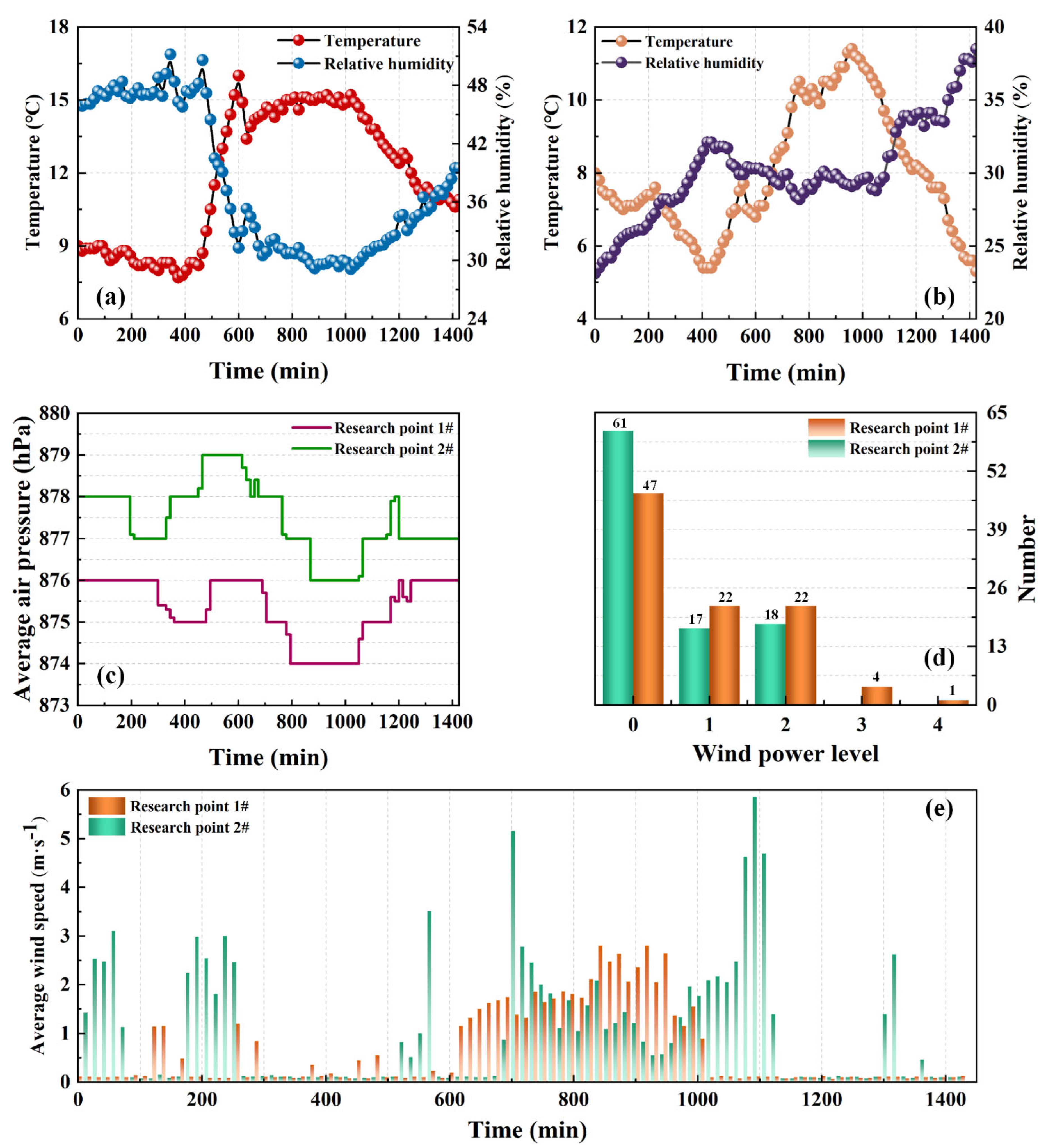


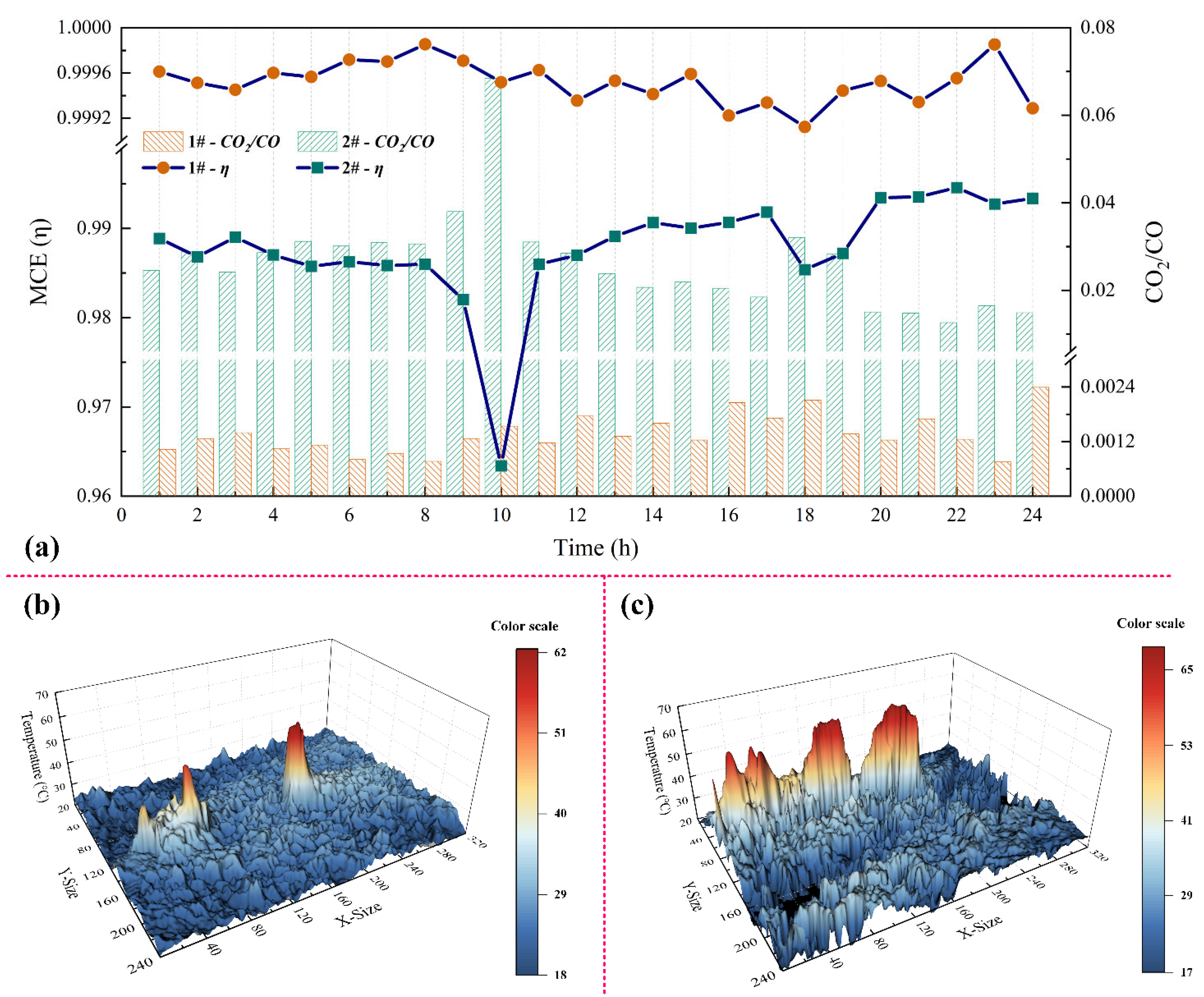
| Module | Sensor | Model | Range | Accuracy | Voltage | |
|---|---|---|---|---|---|---|
| Fissure module | CO2 sensor | DCO2-TF2 | 0–120,000 ppm | ±200 ppm | DC 24V | |
| CO sensor | BSA/QT-ZN (CO) | 0–2000 ppm | ±2%FS | |||
| Bidirectional gas flow sensor | KV621P | 0– ± 10 m/s | 0.2 m/s | |||
| Temperature sensor | CWDZ33 | −50–300 °C | 0.5%FS | |||
| Meteorological module | Meteorological integrated sensor | RS-FSXCS | Wind speed | 0–60 m/s | ±0.2 m/s ± 0.02 × v | |
| Pressure | 0–120 kPa | ±0.15 kPa | ||||
| Temperature | −40 °C–+80 °C | ±0.5 °C | ||||
| Humidity | 0%RH–99%RH | ±3%RH | ||||
| Communities | Total Variance Explained | |||||
|---|---|---|---|---|---|---|
| Factor | Initial | Extraction | Factor | Eigenvalue | ||
| Value | Variance Contribution | Cumulative % | ||||
| CO2 | 1.000 | 0.833 | 1 | 2.673 | 33.417 | 33.417 |
| CO | 1.000 | 0.747 | 2 | 2.554 | 31.921 | 65.338 |
| FT | 1.000 | 0.859 | 3 | 1.075 | 13.435 | 78.773 |
| BW | 1.000 | 0.831 | 4 | 0.730 | 9.122 | 87.895 |
| W | 1.000 | 0.647 | 5 | 0.447 | 5.593 | 93.488 |
| T | 1.000 | 0.831 | 6 | 0.271 | 3.381 | 96.869 |
| RH | 1.000 | 0.793 | 7 | 0.158 | 1.978 | 98.847 |
| P | 1.000 | 0.760 | 8 | 0.092 | 1.153 | 100.000 |
| Factor | Loading Matrix (Aij) | Coefficient Matrix (Cij) | ||||
|---|---|---|---|---|---|---|
| PC1 | PC2 | PC3 | PC1 | PC2 | PC3 | |
| x1 (CO2) | 0.908 | 0.091 | −0.031 | 0.208 | 0.022 | −0.028 |
| x2 (CO) | −0.814 | 0.064 | −0.285 | −0.186 | 0.016 | −0.256 |
| x3 (FT) | 0.195 | 0.906 | −0.016 | 0.045 | 0.222 | −0.014 |
| x4 (BW) | 0.389 | −0.740 | 0.364 | 0.089 | −0.181 | 0.327 |
| x5 (W) | −0.313 | 0.330 | 0.663 | −0.072 | 0.081 | 0.595 |
| x6 (T) | 0.388 | 0.704 | 0.429 | 0.089 | 0.173 | 0.385 |
| x7 (RH) | 0.747 | −0.467 | −0.129 | 0.171 | −0.114 | −0.116 |
| x8 (P) | 0.438 | 0.592 | −0.468 | 0.1 | 0.145 | −0.42 |
| Research Point | Shape Type | Size (m) | Cross-Section Area (m2) | Value (t) | Daily Average Value (t) |
| 1# | Line type | Length: 45; Width: 0.03 | 0.0135 | 2.69 | 2.56 |
| 2# | Round hole type | Long axis: 0.125; Short axis: 0.035 | 0.0137 | 2.42 |
Publisher’s Note: MDPI stays neutral with regard to jurisdictional claims in published maps and institutional affiliations. |
© 2022 by the authors. Licensee MDPI, Basel, Switzerland. This article is an open access article distributed under the terms and conditions of the Creative Commons Attribution (CC BY) license (https://creativecommons.org/licenses/by/4.0/).
Share and Cite
Wang, H.; Fan, C.; Li, J.; Wu, Y.; Xing, S.; Wang, W. A Field Study of Coal Fire Areas Re-Burning Behavior Assessment and Related Carbon Emissions. Fire 2022, 5, 186. https://doi.org/10.3390/fire5060186
Wang H, Fan C, Li J, Wu Y, Xing S, Wang W. A Field Study of Coal Fire Areas Re-Burning Behavior Assessment and Related Carbon Emissions. Fire. 2022; 5(6):186. https://doi.org/10.3390/fire5060186
Chicago/Turabian StyleWang, Haiyan, Cheng Fan, Jinglei Li, Yaling Wu, Shiyue Xing, and Wei Wang. 2022. "A Field Study of Coal Fire Areas Re-Burning Behavior Assessment and Related Carbon Emissions" Fire 5, no. 6: 186. https://doi.org/10.3390/fire5060186
APA StyleWang, H., Fan, C., Li, J., Wu, Y., Xing, S., & Wang, W. (2022). A Field Study of Coal Fire Areas Re-Burning Behavior Assessment and Related Carbon Emissions. Fire, 5(6), 186. https://doi.org/10.3390/fire5060186






